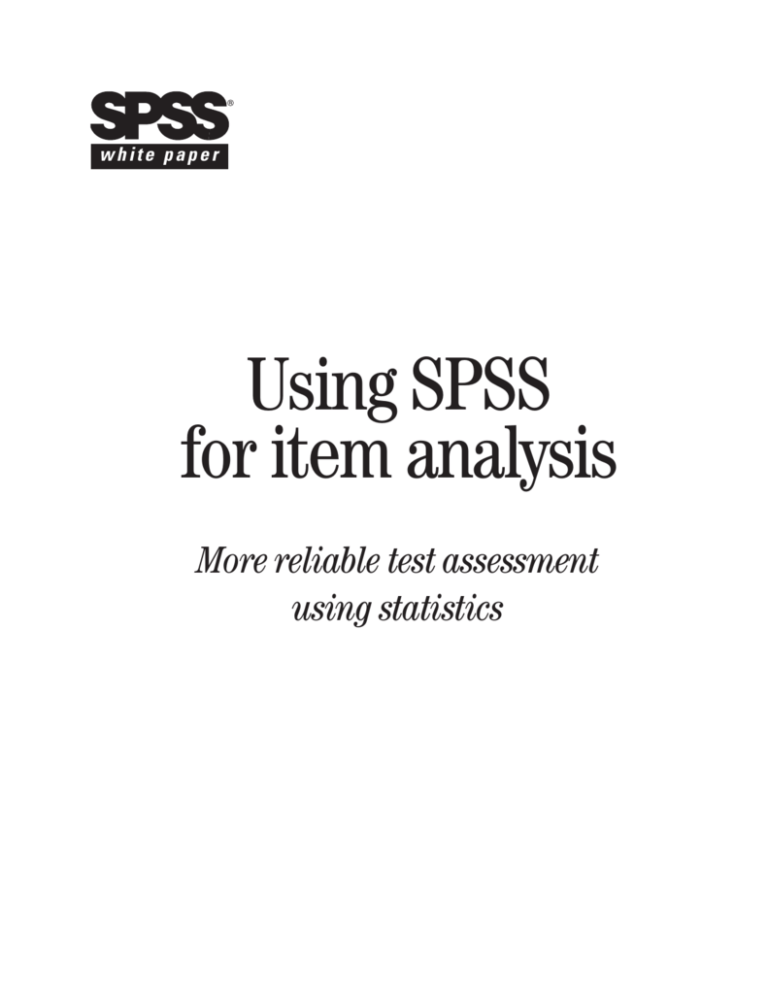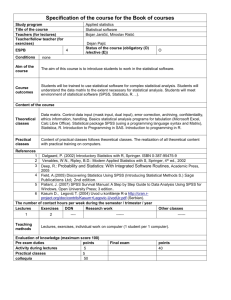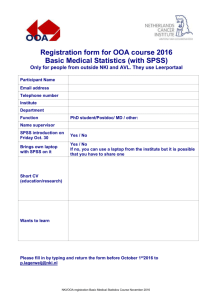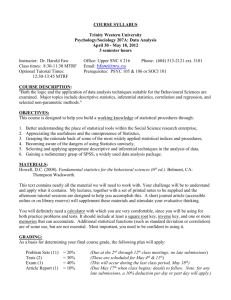
white paper
Using SPSS
for item analysis
More reliable test assessment
using statistics
white paper
Using SPSS for item analysis
2
nstructors frequently assess student learning with multiple-choice question
examinations. These examinations are efficient tools because they do not take long
to grade. Multiple-choice questions, given their presentation of alternative answers,
also called distracters, are also very effective learning assessment tools as well.
I
Instructors who develop their own examinations can enhance the effectiveness of each
test item, or question, if they select and write their items on the basis of item performance data. Such data are available to instructors who submit their test items to item
analysis – a series of procedures that are easily easily implemented with SPSS software.
Administration
Item
Administrative tasks such as test composition, administration and answer collection
can be accomplished with the SPSS line of products. Here are some examples:
■
Remark Office OMR enables you to design your own test forms using any word
processor, print them on any printer, scan them with your desktop scanner and export
the data to an SPSS data format. Remark reads OMR (bubble fields, check boxes, etc.),
barcodes and image fields.
■
Teleform 5 makes it fast and easy to design your own test forms. With Teleform Tri-CR
technology you get three sophisticated recognition engines, so you get near-perfect data
accuracy for hand print recognition, optical character recognition and optical mark
reading. You can easily correct mismarked or illegible responses with the Teleform
Verifier, and store your data as an SPSS data file to get a quick start on data analysis.
■
SPSS Data Entry 1.0 provides a “drag-and-drop” form design feature and enables
either computer-aided test administration (via the Data Entry Station software
package) or test administration over the Web. Either way, the data are captured
in an SPSS data format so it’s immediately ready for analysis.
analysis is
a series of
procedures
that are
easily
implemented
with SPSS
software
Scoring
Once responses to multiple choice questions are
entered into SPSS, scoring the results against the
answer key is a straight-forward procedure within
SPSS. For example, Figure 1a shows a typical test
answer file – where each row represents a particular
student’s answers to a 10-answer multiple choice
exam. The last row is the answer key.
The next figure (Figure 1b) shows the same set
of answers, but this time coded “1” (correct) and
“0” (wrong). Additionally, each student’s score
(percentage of correct answers) has been recorded –
as well as how that student compared (top, middle
or bottom one-third) with other students in the class.
Figure 1a
A typical test answer file
white paper
Using SPSS for item analysis
reliable tool
Figure 1b
A typical test answer file with answers coded correctly (1)
and incorrectly (0)
to help you
The Index of Discrimination
accurately
SPSS offers reliable computation of the Index
of Discrimination. One example of a measure
of effectiveness for a particular test item is
the difference between the percentage of
students in the top one-third of the class who
correctly answered that test item and the
percentage in the bottom one-third who correctly
answered the item. Figure 2 shows the result.
SPSS is a
compute
Index of
Discrimination
This index should be viewed in the context
of the overall difficulty of the question. For
example, the Index of Discrimination might
not be useful for a question that only 10
percent of the overall class answered correctly. Figure 2
Index of Discrimination
In most circumstances, however, viewing the
correct percentage in each one-third of the class
(as in Figure 2) is useful in and of itself. SPSS produces these results accurately
and efficiently.
Other statistical items of importance
Ideally, one would want the “correctness” of a particular item on a test to be associated
with a high overall score (percentage of all items answered correctly). Taken from a
different angle, you may prefer “frequently answered correctly” test items from students
who did well on the test overall. This association between individual test item and overall
test performance is called the point biserial correlation. A more useful correlation is the
overall test performance computed excluding the particular test item in question. This
measure is called the corrected point biserial correlation of a test item.
3
white paper
Using SPSS for item analysis
SPSS
provides
a measurement of
the internal
consistency
of the test
items
Figure 3
Output for the SPSS Reliability program
SPSS gives test developers a means of measuring consistency. SPSS provides a
measurement of internal consistency (reliability) of the test items called Cronbach’s
Alpha. The higher the correlation among the items, the greater the alpha. High
correlations imply that high (or low) scores one question are associated with high
(or low) scores on other questions. Alpha can vary from 0 to 1, with indicating that
the test is perfectly reliable. Furthermore, the computation of Cronbach’s Alpha when
a particular item is removed from consideration is a good measure of that item’s
contribution to the entire test’s assessment performance. In the SPSS output above
(Figure 3), these and other statistics are automatically generated using a procedure
called Reliability (in the output, the term scale refers to the collection of all test items).
Note the column “Corrected Item-Total Correlation.” This column displays the corrected
point biserial correlation. You can see that question three seems to correlate well with
overall test performance. On the other hand, students who tend to do poorly on the test
overall tend to answer question eight correctly. This is not a desired outcome. Notice also
the “Alpha” in the lower left-hand corner and the column titled “Alpha if Item Deleted.”
If question eight is deleted from the scale, the Alpha statistic climbs to .68. With this
perspective, question eight needs to be critically examined and perhaps rewritten.
Distracter analysis
In a multiple-choice question, the incorrect choices are called “distracters.” When
creating test questions, consider the following:
■
A percentage of students should select each distracter (in lieu of the correct answer)
or the distracter is not effective.
■
If too great a percentage of students select a particular distracter, there might be an
ambiguity in the wording of the question or the wording of that particular distracter.
4
white paper
Using SPSS for item analysis
■
5
A distracter has value if the percentage of students selecting it differed based on their
overall test performance. A good distracter is one that is selected by few students who
were in the top third of the class, but chosen by many students in the bottom third.
Building a table that
provides this type of
analysis for each test
item is, again, an easy
procedure in SPSS. Figure
4 shows the distracter
Figure 4
analysis output for
Distracter Analysis
question two of our test.
Item analysis
enables
In the output, the four distracters are displayed across the columns, along with the
correct answer to the question (answer 4) marked with an asterisk. Notice the following:
■
Overall, 12.5 percent of the students chose distracter five. However, among the top
one-third of the performers on the test, 50 percent chose that distracter. In the middle
and bottom thirds, no one chose distracter five. This is an indication that there is
perhaps an ambiguity in the wording of the question – or the distracter – which
was apparent to the better performers.
■
Overall, 12.5 percent of the test takers chose distracter one. In the top and middle
thirds, no one selected it. And, in the bottom one-third, 33 percent selected distractor
one. It seems that this distracter is performing as it should.
instructors to
improve their
classroom
practices
and allows
item writers
to enhance
Productivity-enhancing tools
SPSS is as flexible as it is powerful and can be adapted to your teaching environment.
Consider the following:
■
SPSS makes test administration tasks more productive. SPSS can be used in the interactive mode wherein the kinds of tables and data transformations illustrated in this
paper can be accomplished on the fly. This method is useful for researchers who are
interested in more in-depth analyses. An intuitive Windows interface makes these
tasks simple – even for first-time SPSS users.
■
SPSS can be customized for increased flexibility. When appropriate, each of these
procedures can be easily added to the menu bar.
■
SPSS can also run in production mode. This is useful, for example, if you are interested
in running the same item analysis procedures every time you administer a test.
their tests
Summary
Item analysis is an extremely useful set of procedures available to teaching professionals.
SPSS is a powerful statistical tool for measuring item analysis and an ideal way for educators to create – and evaluate – valuable, insightful classroom testing tools. Item analysis
enables instructors to improve classroom practices and enables test writers to enhance
their examinations. SPSS is an ideal tool in accurate item analysis.
white paper
Using SPSS for item analysis
6
About SPSS
SPSS Inc. is a multinational software company that delivers “Statistical Product and Service
Solutions.” Offering the world’s best-selling desktop software for in-depth statistical analysis
and data mining, SPSS also leads the markets for data collection and tabulation.
Customers use SPSS products in corporate, academic and government settings for all types
of research and data analysis. The company’s primary businesses are: SPSS (for business
analysis, including market research and data mining, academic and government research);
SPSS Science for scientific research; and SPSS Quality for quality improvement.
Based in Chicago, SPSS has offices, distributors and partners worldwide. Products run
on leading computer platforms, and many are translated into Catalan, English, French,
German, Italian, Japanese, Korean, Russian, Spanish and traditional Chinese. In 1997,
the company employed nearly 800 people worldwide and generated net revenues of
approximately $110 million.
Contacting SPSS
To place an order or to get more information, call your nearest SPSS office or visit our
World Wide Web site at www.spss.com
SPSS Inc.
+1.312.651.3000
Toll-free: +1.800.543.2185
SPSS Argentina srl.
+541.814.5030
SPSS Asia Pacific Pte. Ltd.
+65.245.9110
SPSS Australasia
Pty. Ltd.
+61.2.9954.5660
Toll-free: +1800.024.836
SPSS Israel Ltd.
+972.9.9526700
SPSS Italia srl
+39.51.252573
SPSS Japan Inc.
+81.3.5466.5511
SPSS Kenya Ltd.
+254.2.577.262
SPSS Korea KIC Co., Ltd.
+82.2.3446.7651
SPSS Belgium
+32.162.389.82
SPSS Latin America
+1.312.651.3226
SPSS Benelux
+31.183.636711
SPSS Malaysia Sdn Bhd
+60.3.704.5877
SPSS Central and
Eastern Europe
+44.(0)1483.719200
SPSS Mexico Sa de CV
+52.5.682.87.68
+420.2.24813839
SPSS Middle East
& South Asia
+91.80.545.0582
SPSS Czech Republic
SPSS East Mediterranea
& Africa
+972.9.9526701
SPSS Polska
+48.12.6369680
SPSS Russia
+7.095.125.0069
SPSS Federal Systems
+1.703.527.6777
SPSS Scandinavia AB
+46.8.506.105.50
SPSS Finland Oy
+358.9.524.801
SPSS Schweiz AG
+41.1.266.90.30
SPSS France SARL
+33.1.5535.2700
SPSS Singapore Pte. Ltd.
+65.533.3190
SPSS Germany
+49.89.4890740
SPSS South Africa
+27.11.706.7015
SPSS Hellas SA
+30.1.7251925
SPSS Taiwan
+886.2.25771100
SPSS UK Ltd.
+44.1483.719200
SPSS Hispanoportuguesa S.L. +34.91.447.37.00
SPSS Hong Kong Ltd.
+852.2.811.9662
SPSS Ireland
+353.1.496.9007
© SPSS Inc. 1998. All rights reserved. SPSS® is a registered trademark of SPSS Inc.
All other products are trademarks of their respective owners.
Printed in the U.S.A. SWPIA-0898M










